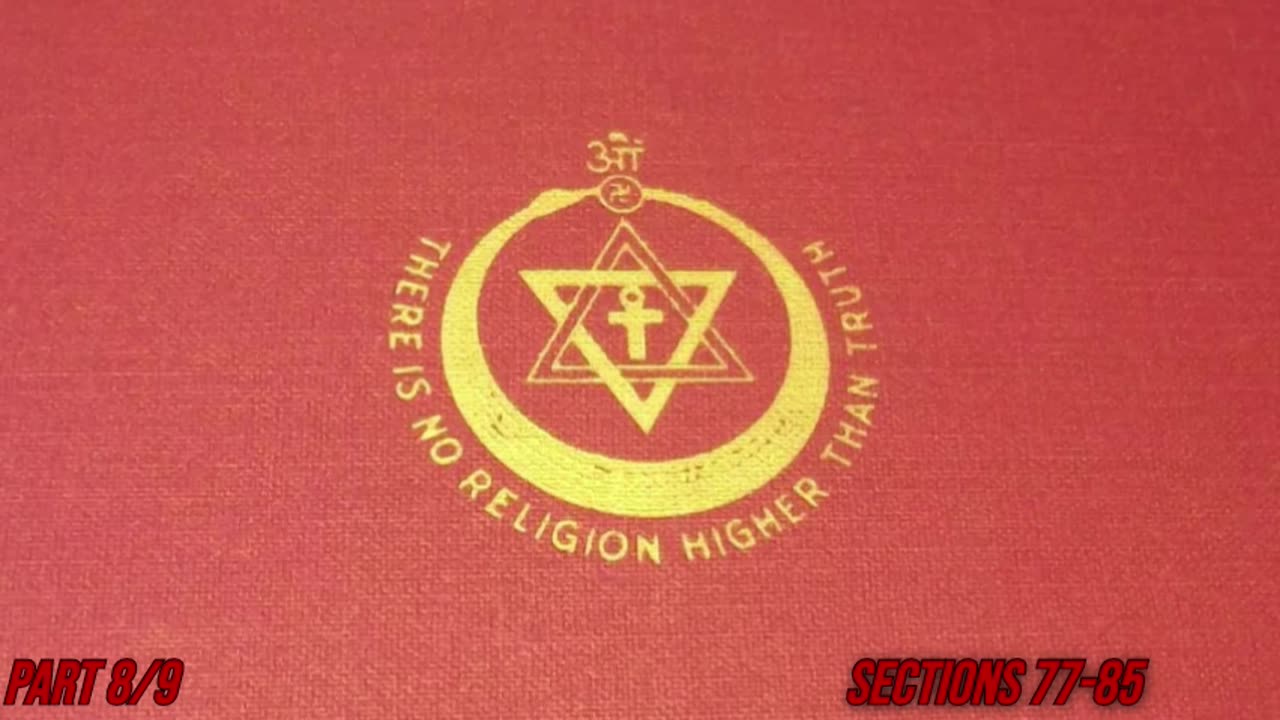Premium Only Content

The Secret Doctrine by Blavatsky Part 8/9 Sections 77-85
Part 8 (Sections 77-85) of "The Secret Doctrine" by Helena Petrovna Blavatsky continues the intricate discussion of cosmic principles, esoteric evolution, and the hidden aspects of human nature. This part emphasizes the interplay between spiritual forces and physical matter, exploring how universal laws manifest in both the macrocosmic and microcosmic realms. Blavatsky delves into the influence of ancient esoteric teachings on world history and the development of religious thought, continuing her critical stance on materialist science while offering a mystical perspective on the nature of reality.
Overview of Part 8:
In this section, Blavatsky places a strong focus on the dual nature of existence, emphasizing how spirit and matter are two sides of the same coin. She explores the symbolic significance of mythological narratives, sacred texts, and occult doctrines, aiming to reveal their hidden truths about human destiny and spiritual awakening. This part serves as a continuation of the themes of inner transformation and spiritual evolution, highlighting the eternal struggle between material desires and spiritual enlightenment.
Key Concepts and Sections in Part 8:
1. Spirit and Matter: The Eternal Duality:
Blavatsky emphasizes that spirit and matter are not opposites but complementary aspects of the same reality. She explains that matter is simply spirit in its densest form, while spirit represents the highest state of subtlety and consciousness.
This duality is seen in the manifestation of the universe, where divine consciousness takes on a physical form through the process of creation. Blavatsky draws on Hindu cosmology, particularly the concepts of Purusha (spirit) and Prakriti (matter), to illustrate this interconnectedness.
The tension between material existence and spiritual aspiration is portrayed as a universal law, driving the evolution of both individual souls and entire worlds.
2. The Role of Myths and Symbols in Spiritual Knowledge:
Blavatsky explores how mythological narratives serve as allegories for spiritual truths. She believes that myths from cultures like Egyptian, Greek, Hindu, and Norse traditions encode esoteric teachings about the nature of the cosmos and the journey of the soul.
For example, she interprets the myth of Prometheus as a symbol of divine wisdom being imparted to humanity, reflecting the descent of spirit into matter and the struggle for enlightenment. Similarly, she discusses Hercules’ labors as metaphors for the challenges faced by spiritual aspirants.
Blavatsky suggests that understanding these symbolic narratives can unlock deeper spiritual insights, revealing the cosmic principles that guide human evolution.
3. The Fall and Rise of Consciousness:
A central theme in Part 8 is the cyclical nature of spiritual consciousness—the descent into materiality and the aspiration towards spiritual transcendence. Blavatsky describes this cycle as being mirrored in the history of civilizations, where periods of material focus are followed by spiritual awakenings.
This theme ties into her broader critique of modern science and dogmatic religion, which she believes focus too much on the exoteric aspects of existence without recognizing the spiritual underpinnings of reality. She argues that true knowledge comes from understanding the inner worlds and their influence on the outer world.
Blavatsky aligns this spiritual cycle with the Law of Cycles, which governs both the cosmos and human consciousness.
4. Esoteric Teachings of the Ancient East:
Part 8 draws heavily on Eastern spiritual traditions, including Vedantic and Buddhist teachings, to explain the spiritual journey. Blavatsky discusses concepts such as Maya (illusion), Atman (the soul or self), and Bodhisattva (an enlightened being who helps others).
She positions Eastern philosophy as being more closely aligned with the ancient wisdom tradition, which she argues has been lost in Western religious thought. According to Blavatsky, the esoteric doctrines of the East provide keys to understanding the invisible dimensions of the cosmos and human nature.
She connects these Eastern concepts to the teachings of the mystery schools, suggesting that they all originate from a shared esoteric source.
5. Spiritual Beings and Cosmic Hierarchies:
Blavatsky further discusses the role of spiritual beings, such as devas, archangels, planetary spirits, and elemental entities, in guiding the evolution of the universe. These beings act as intermediaries between the spiritual realms and the physical world, ensuring that cosmic laws are maintained.
She elaborates on the idea of spiritual hierarchies that influence the development of stars, planets, and life on Earth, suggesting that human spiritual growth is intimately connected to the work of these beings.
Blavatsky's view of these hierarchies is aligned with Gnostic cosmology and Hermetic traditions, where spiritual forces play a crucial role in manifesting reality.
6. The Path of Initiation and the Search for Wisdom:
A significant portion of this section is dedicated to the path of initiation, which Blavatsky describes as a journey that allows individuals to transcend the limitations of material reality and access higher states of consciousness.
She details the tests and trials that initiates undergo, which are designed to purify the mind and spirit, allowing them to access the secrets of the universe. Blavatsky emphasizes that true spiritual knowledge comes from direct experience and inner transformation, rather than merely intellectual understanding.
The path of initiation is portrayed as a universal quest, found in the teachings of Hermeticism, Kabbalah, Taoism, and Buddhism, each offering methods and practices for the seeker to align with divine consciousness.
Purpose of Part 8:
This section aims to provide deeper insight into the relationship between spiritual knowledge and mythology, emphasizing that symbolic language holds the keys to universal truths. Blavatsky seeks to demonstrate that the spiritual journey is a timeless quest, undertaken by initiates throughout history.
Blavatsky's emphasis on esoteric interpretations of sacred texts and cosmic principles is intended to challenge materialist perspectives, encouraging readers to explore the mystical dimensions of reality and their own consciousness.
Style and Presentation:
The style of Part 8 is rich in symbolism, filled with comparative references to mythology, Eastern spirituality, and Western mysticism. Blavatsky writes with a tone of spiritual authority, assuming that readers are open to exploring the hidden meanings behind mythological and religious symbols.
Her writing is layered with occult references, designed to appeal to those who are willing to delve into the deeper mysteries of existence.
Significance of Part 8:
Part 8 is significant for its attempt to synthesize ancient mystical traditions with theosophical teachings, offering readers a framework for understanding the unseen dimensions of reality and the symbolic language that expresses these truths.
This section provides a roadmap for those interested in the mystical path, highlighting how mythology, spiritual initiation, and esoteric knowledge are essential tools for self-discovery and cosmic understanding.
ABOUT THE AUTHOR:
Helena Petrovna Blavatsky (1831-1891)
Helena Petrovna Blavatsky—often known simply as Madame Blavatsky or HPB—was a Russian occultist, mystic, and co-founder of the Theosophical Society, a movement that sought to reconcile spirituality with science and philosophy by drawing upon ancient esoteric traditions. Born on August 12, 1831, in Ekaterinoslav, then part of the Russian Empire (now Dnipro, Ukraine), she is widely considered one of the most influential figures in the modern esoteric and occult revival of the late 19th century. Her writings and teachings, particularly "Isis Unveiled" (1877) and "The Secret Doctrine" (1888), continue to shape New Age thought, Western esotericism, and spiritual movements to this day.
Early Life and Influences
Blavatsky was born into a noble Russian family, with her mother, Helena Andreyevna von Hahn, being a novelist and her father, Colonel Peter Hahn, serving in the Russian military. From a young age, she displayed an interest in the mystical and supernatural, with accounts of her life mentioning experiences with clairvoyance, telepathy, and astral travel. Her family's access to Western literature and philosophy exposed her to esoteric ideas early on, which she later developed into her own theosophical framework.
In her early adulthood, Blavatsky embarked on extensive travels that took her across Europe, the Middle East, India, and Tibet. During these journeys, she claimed to have studied with esoteric teachers and initiates, particularly in India and Tibet, who taught her the ancient wisdom traditions that would form the core of her later teachings.
Founding of the Theosophical Society
In 1875, Blavatsky co-founded the Theosophical Society in New York City with Henry Steel Olcott and William Quan Judge. The society aimed to:
1. Promote the study of comparative religion, philosophy, and science.
2. Investigate unexplained laws of nature and the powers latent in humanity.
3. Promote universal brotherhood, transcending distinctions of race, creed, sex, caste, or color.
The Theosophical Society played a pivotal role in introducing Eastern philosophies, such as Hinduism and Buddhism, to the Western world, promoting the idea that all religions contain an underlying spiritual truth. Blavatsky served as the spiritual head of the movement, positioning herself as a messenger for the hidden masters or Mahatmas, whom she claimed were enlightened beings guiding the spiritual evolution of humanity.
Key Works and Esoteric Teachings
"Isis Unveiled" (1877): Blavatsky’s first major work sought to challenge materialism and scientific reductionism, arguing that ancient wisdom held the keys to understanding spiritual phenomena and the hidden aspects of nature. The book covered a wide range of subjects, from mythology to comparative religion, psychic phenomena, and occult sciences.
"The Secret Doctrine" (1888): This two-volume work is considered her magnum opus. It lays out a cosmological vision based on the Stanzas of Dzyan, which she claimed were ancient texts from Tibet. The first volume, "Cosmogenesis", focuses on the origin of the universe and cosmic evolution, while the second volume, "Anthropogenesis", explores the esoteric history of humanity through the seven root races. Blavatsky aimed to provide a synthesis of science, religion, and philosophy, drawing upon Eastern mysticism, Hermeticism, and Kabbalistic traditions.
Affiliations with Secret Societies
Blavatsky’s life and work were deeply intertwined with the esoteric traditions and secret societies that she studied and promoted. While there is some ambiguity surrounding her precise affiliations, her connections to various mystical and occult orders are well-documented:
1. Freemasonry:
Blavatsky claimed connections with Freemasonry, particularly through Co-Freemasonry and esoteric branches of the craft that included women, which was unusual for traditional Freemasonry. She was associated with Rite of Adoption lodges, a branch of Continental Masonry that allowed female members.
Her writings often reflect a Masonic worldview, utilizing symbolism and concepts familiar to Masonic teachings, such as the spiritual significance of geometric shapes and initiatory practices.
2. Rosicrucianism:
Blavatsky’s teachings frequently align with Rosicrucian ideals, emphasizing the existence of a hidden knowledge that dates back to ancient Egypt, Hermeticism, and alchemical traditions. She often spoke of the Rosicrucians as being among the guardians of ancient wisdom.
While no direct records confirm her initiation into a formal Rosicrucian order, Blavatsky’s writings suggest a deep sympathy for Rosicrucian principles, particularly in her emphasis on spiritual alchemy and the transmutation of the soul.
3. Hermetic Brotherhood of Luxor:
Blavatsky’s early writings and teachings have connections to the Hermetic Brotherhood of Luxor, a 19th-century occult order that combined Egyptian mysteries with Western esotericism. Some sources suggest that she had correspondences with members of this brotherhood, sharing a common interest in ancient Egyptian mysticism.
The Hermetic principles she discusses in her writings, such as the Law of Correspondence ("As above, so below"), reflect the influence of Hermetic thought on her theosophical worldview.
4. Kabbalistic Traditions:
Blavatsky’s work is heavily influenced by Jewish Kabbalah, which she viewed as a repository of esoteric wisdom with roots in ancient Chaldean and Egyptian mysticism. She believed that Kabbalistic teachings were closely related to the mysteries of the East, drawing parallels between Kabbalistic concepts and Vedic philosophy.
Although not formally initiated into any Kabbalistic society, Blavatsky incorporated Kabbalistic symbols, such as the Sephiroth and the Tree of Life, into her interpretation of the cosmos and spiritual evolution.
Controversies and Criticisms
Blavatsky’s life and work were marked by significant controversy. She faced criticism and skepticism from the scientific community of her time, as well as from Christian missionaries who opposed her promotion of Eastern religions in the West. Her claims of communication with the Mahatmas were challenged by skeptics, most notably during the Hodgson Report published by the Society for Psychical Research in 1885, which accused her of being a charlatan. However, many of her followers continued to believe in her spiritual authority and the validity of her occult experiences.
Legacy and Impact
Blavatsky’s influence extends far beyond her lifetime, shaping the New Age movement, Western occult traditions, and esoteric schools of thought. Her emphasis on the unity of all religions, the divine nature of the cosmos, and the importance of spiritual evolution has had a profound impact on mystical traditions and philosophical inquiries into the nature of reality. The Theosophical Society she co-founded continues to have branches around the world, promoting the study of esoteric philosophy and spiritual science.
Helena Petrovna Blavatsky remains a polarizing figure—revered by many as a spiritual visionary and pioneer of esoteric thought, while criticized by others as a controversial mystic with unorthodox ideas. Regardless of perspective, her role in reshaping the Western spiritual landscape and bridging Eastern and Western philosophies is undeniable, making her a central figure in the history of modern esotericism.
-
 3:25:21
3:25:21
Deus Meum Que Jus
11 days agoMarx & Satan by: Richard Wurmbrand (1986)
231 -
 2:29:20
2:29:20
DLDAfterDark
5 hours ago $5.17 earnedDLD Live! That Sh... Will Get You K***ed! What To Consider in SHTF
32K1 -
 2:15:08
2:15:08
megimu32
8 hours agoON THE SUBJECT: IRL Streamers Attacked & Nostalgic Animal Movies That Made Us Cry
55.4K5 -
 1:00:54
1:00:54
The Tom Renz Show
12 hours agoMore Epstein/FBI, a Scary Trade War, & the Dem Echo Chamber
47.2K11 -
 40:43
40:43
Kimberly Guilfoyle
13 hours agoDems Double Down on Delusion-Why? Live with Tony Kinnett & Bo French | Ep.202
125K44 -
 1:28:42
1:28:42
Redacted News
11 hours agoBREAKING! SOMETHING BIG IS HAPPENING IN EUROPE ALL OUT WAR IS COMING AGAINST RUSSIA, TRUMP FURIOUS
174K340 -
 47:50
47:50
Candace Show Podcast
12 hours agoBREAKING: Judge Makes Statement Regarding Taylor Swift's Text Messages. | Candace Ep 155
158K137 -
 1:14:23
1:14:23
Josh Pate's College Football Show
8 hours ago $2.68 earnedCFB’s Most Hated Teams | FSU & Clemson Future | Big Ten Win Totals | Star Rankings Overrated?
39.6K -
 1:33:47
1:33:47
CatfishedOnline
10 hours agoGoing Live With Robert - Weekly Recap
47.9K1 -
 55:18
55:18
LFA TV
1 day agoEurope’s Sudden Turn Against America | TRUMPET DAILY 3.6.25 7PM
48.9K3